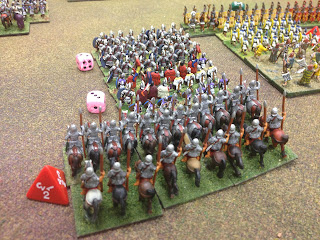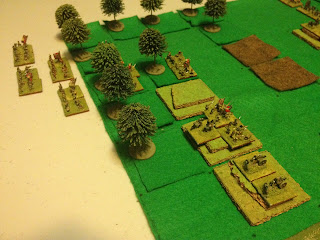Some email discussion showed that, by pooling of resources, we could throw together some suitable armies. Ralph, who would be running the game, isn't really up on Ancients either, so wanted to do a simple Roman/Barbarian fight. various people brought figures from their collections, which were thrown together into units which, whilst not resembling anything historical, looked like masses of men.
Peter was bringing most of the figures, but tends to turn up later in the evening, so we improvised a quick intro game; three units of Men With Spears were classed as Roman auxiliary infantry, and a force of four Barbarian warbands were pitted against them.
Being bearded, I took the Barbarians. Initially they seemed to be commanded by an all-girl morris-dancing group:.
However we swapped that for a more conventional chariot.
Caesar commanded the Roman invaders. Obviously.
Barbarian tactics are not subtle - I charged. Or I charged one mass anyway; not knowing how combat worked I didn't want to commit the whole army until I'd seen how things might pan out:
Things didn't go too well. The Barbarians made a tactical withdrawal:
With nothing left to lose I just chucked everything in, and achieved a push-back on the other flank:
There was some hard fighting in the centre as well:
But on the whole the Barbarians failed to break the Roman line. However since one of their units was now behind its starting position, and the others hadn't advanced, I claimed victory on the grounds that the Romans controlled less of Germany than when they had started ...
This week's Guest Star is the pterosaur the role-players had drawn on the white-board in their room:
Meanwhile Peter had arrived and sorted out two armies from his collection of figures. On one side we had some Romans who mostly looked like Romans - legionaries, some auxiliaries, a few archers, cataphract cavalry and a couple of units of artillery. On the other side were barbarians, made up of whatever figures we had left. Some of them were quite colourful, suggesting that the land being fought over would become, 1700 years later, Riskovia. Caesar and I took the Barbarians (which gave me an excuse if we lost if nothing else) whilst Peter and John handled the Romans. Ralph adjudicated and looked startled as we asked him complex questions:
The Barbarians had cavalry. I commanded it. Any Staines Wargamers reading this will know that this cannot end well ...
A good start. As my cavalry plodded slowly forward (I said 'Charge', but they obviously misheard me), one unit took a single hit from some long-range artillery fire. And routed.
The Roman firing-line: artillery and archers. This is what my troops were advancing towards.
My surviving cavalry failed to charge again:
Indeed the Romans got so bored waiting for us to attack that they came to me instead. We discovered that, whilst on paper the difference between their cataphracts and the barbarian cavalry isn't that great, in reality those lances and that extra point on the save gives them quite an edge:
Whilst Caesar thought about tactics with his infantry I just did what Barbarians do best with mine - I got stuck in:
Here's my wing of the Barbarian army falling back, or being pushed back. Getting stuck in is a high-risk strategy:
On the other flank John moved his artillery into an enfilade position. The Roman artillery really gave us a taste of what ACW Black Powder might be like; they caused us no end of trouble:
Caesar decides to fight. And actually does OK:
However the Roman cavalry, having polished off their Barbarian counterparts, now smacked into the back of my warbands. Not good.
At this point we called time. This was our dead-pile:
And this was the Roman's dead-pile - I did for the artillery unit, whilst Caesar managed to break some legionaries:
I think we all enjoyed the game, with its sweeping, and non-fiddly, moves. The big handfuls of dice can make combat very random sometimes, and the Roman artillery was stupidly lucky in rolling sixes (which force a morale test) so seemed to do damage far in excess of their numbers. I'm looking forward to trying the system in a period with guns, now.
Thanks to John, Caesar and Peter for providing figures, and to Ralph for organising the game. I just brought my dice, tape-measure and a camera.




















































